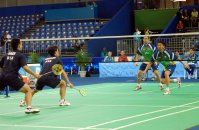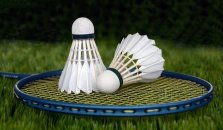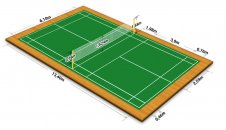
Although the badminton seems simple when it is seen on television, mastering the proper technique, both to play and to prevent injuries, is much more complex than expected. Therefore, if you want to progress the best is to look for a coach, or go to a sports club, where you will find the precise guidance to learn how to handle the keys to the practice of badminton.
You also need some pieces of equipment to play this game like badminton. Like Badminton rackets, net, shoes and etc.
At the time of buying the material, in the case of a beginner, it is not necessary that it is the best one that is in the market, because it probably does not take out all the potential, and the misuse can end up spoiling it quickly. The most successful thing is to buy medium quality products, which will prevent them from breaking easily, and if after this sport is practiced regularly there will always be time to improve the material that is available.
Equipment needed to practice badminton
The practice of badminton requires few elements, one of the factors that have made it a sport for all audiences:
The Court and Badminton Net
To practice badminton, first you need a space to play, a track with the appropriate dimensions, which are 13.40 meters long and 6.10 meters wide – although in an individual is played at 5.18 meters. The net must be placed at 1.52 meters in singles and 1.55 in doubles.
If you do not have a track and a network, you can search for any space and mark it with chalk to meet the requirements of the World Badminton Federation (BWF). The net can be simulated with a rope tied to two points at the appropriate height, knowing that the steering wheel always has to pass over.
Badminton racket
Most practitioners invest more money in searching for the badminton racket because it is the most personal element, both for the quality and the design. You can choose any model that complies with the regulations of the BWF, which in terms of size can not exceed 68 centimeters long and 23 inches wide. They are usually made of granite, titanium or steel.
Best Badminton rackets consist of five parts:
- The handle or grip, which is where it grabs.
- The stick or rod, which joins the handle with the head or crosshead, measures about 20 cm and is characteristically thinner than in the rackets of other sports.
- The crosshead or throat, which is a kind of neck that is between the stick and the head and makes the racquet more resistant, but exists in all rackets.
- The head or frame, which is the circular metal that surrounds the area of the strings with which the steering wheel is struck.
- The string: the part intended for the strings has to be flat, with a uniform synthetic strings design, avoiding that it is denser at the edges than at the center; This area must have maximum dimensions of 28 centimeters in length and 22 centimeters in width.
The racket cannot be modified so that it can change shape, nor can any type of object be changed, except for those approved to prevent wear, breakage and vibration of the ropes.
The prices of the badminton rackets are very varied depending on the quality and characteristics of the same. In the big sports centers, there are models that cost from 6 euros, but the professionals do not fall below 100 euros, easily doubling or tripling that figure.
The Shuttlecock
The other most characteristic element of badminton is the steering wheel. At present they are manufactured with natural or synthetic feathers; Whatever they are, they must have a punchable base of cork covered with a thin layer of leather.
In addition, they must respect the rules of the BWF, which specify that the badminton shuttle must have 16 equal feathers between 62 and 70 mm, which must be anchored to the base, which must be between 25 and 28 mm in diameter. The weight of the steering wheel should oscillate between 4.74 and 5.50 grams. In the case of the flyers of synthetic feathers, it is allowed that measures are modified up to 10% by the difference between the materials.
Shoes
Regarding the badminton shoes, the choice will depend on the style of play of each practitioner. Those more conservative who usually play at the bottom of the track should choose ones with great support and stability to protect properly in turns and sprints, as well as extra protection in the tread, indicated in the phases of landing and takeoff.
For their part, the most attacking players who climb the net a lot need shoes with good traction on the soles to facilitate constant and sudden changes of direction, as well as having a good grip, which will help prevent injuries. Its price usually ranges from 50 dollars of basic models to 200 dollars of the most professional.






